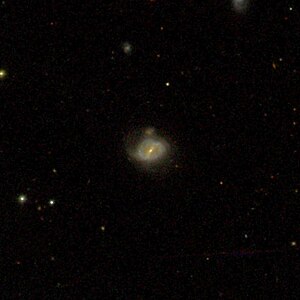NGC 831
| Galaxy NGC 831 |
|
|---|---|

|
|
| SDSS recording | |
| AladinLite | |
| Constellation | whale |
|
Position equinox : J2000.0 , epoch : J2000.0 |
|
| Right ascension | 02 h 09 m 34.6 s |
| declination | + 06 ° 05 ′ 47 ″ |
| Appearance | |
| Morphological type | Spiral |
| Brightness (visual) | 14.4 mag |
| Brightness (B-band) | 15.3 mag |
| Angular expansion | 0.4 ′ × 0.3 ′ |
| Position angle | 102 ° |
| Surface brightness | 11.9 mag / arcmin² |
| Physical data | |
| Redshift | 0.024000 +/- 0.000067 |
| Radial velocity | 7195 +/- 20 km / s |
|
Stroke distance v rad / H 0 |
(324 ± 23) x 10 6 ly (99.2 ± 7.0) Mpc |
| history | |
| discovery | Albert Marth |
| Discovery date | November 18, 1863 |
| Catalog names | |
| NGC 831 • PGC 8241 • CGCG 413-049 • KUG 0206 + 058 • 2MASX J02093460 + 0605467 • | |
NGC 831 is a galaxy of Hubble type S? in the constellation whale of the south of the celestial equator. It is estimated to be 324 million light-years away from the Milky Way and has a diameter of about 35,000 ly.
In the same area of the sky there are u. a. the galaxies NGC 825 , NGC 844 , IC 208 .
The object was on 18 November 1863 by the astronomer Albert Marth using a 48-inch - telescope discovered.
Web links
Individual evidence
